Conservation

The Harapan Rainforest is managed under a 95-year license by a group of NGOs comprising Burung Indonesia, Birdlife International and the Royal Society for the Protection of Birds. [3]
Harapan Rainforest is a 98,555-hectare area of rainforest in the province of Jambi, Sumatra, Indonesia. [1] The British Royal Society for the Protection of Birds is campaigning to plant one million new trees to renew the forest because of its rich wildlife, which is vulnerable to the logging industry. [2]
Despite having been selectively logged in the 1970s, the forest is still considered among the most biodiverse on the planet, containing about 20% of the remaining lowland forests of Sumatra. It provides habitat to over 300 species of bird, as well as the critically endangered Sumatran tiger and Sumatran elephant. [1]

The Harapan Rainforest is managed under a 95-year license by a group of NGOs comprising Burung Indonesia, Birdlife International and the Royal Society for the Protection of Birds. [3]
A proposed 51 km long and 50-m-wide highway through the area that would enable 850 truckloads of coal a day to pass is considered by environmental groups as a major threat to the wildlife. The proposal would remove an estimated 154 hectares of rainforest, would ease access for illegal hunters and loggers and would fragment the habitat of the Sumatran tigers. [1]
Small holder conversion of the forest to oil palm is another major threat to the forest and the objectives of ecosystem restoration.

The Sumatran tiger is a population of Panthera tigris sondaica on the Indonesian island of Sumatra. It is the only surviving tiger population in the Sunda Islands, where the Bali and Javan tigers are extinct.

Gunung Leuser National Park is a national park covering 7,927 km2 in northern Sumatra, Indonesia, straddling the border of Aceh and North Sumatra provinces, a fourth portion and three-fourths portion, respectively. The national park, settled in the Barisan mountain range, is named after Mount Leuser (3,119 m), and protects a wide range of ecosystems. An orangutan sanctuary at Bukit Lawang is located within the park. Together with Bukit Barisan Selatan and Kerinci Seblat National Parks, it forms a World Heritage Site, the Tropical Rainforest Heritage of Sumatra.

Way Kambas National Park is a national park covering 1,300 km2 (500 sq mi) in Lampung province of southern Sumatra, Indonesia. It consists of swamp forest and lowland rain forest, mostly of secondary growth as result of extensive logging in the 1960s and 1970s. Despite decreasing populations, the park still has a few critically endangered Sumatran tigers, Sumatran elephants and Sumatran rhinoceroses. It also hosts over 400 bird species.

Kerinci Seblat National Park is the largest national park on the island of Sumatra, Indonesia. It has a total area of 13,791 km2 and spans four provinces: West Sumatra, Jambi, Bengkulu, and South Sumatra.

Leuser Range or MountLeuser is a stratovolcano located in the Aceh province on the island of Sumatra, Indonesia. It is part of the Leuser Ecosystem, which is one of the most biodiverse regions in the world and a key conservation area for endangered species.
The Tropical Rainforest Heritage of Sumatra site was inscribed as a UNESCO World Heritage Site in 2004. It comprises three Indonesian national parks on the island of Sumatra: Gunung Leuser National Park, Kerinci Seblat National Park and the Bukit Barisan Selatan National Park. The site is listed under Criteria vii - outstanding scenic beauty; ix- an outstanding example representing significant on-going ecological and biological processes; and x- contains the most important and significant natural habitats for in-situ conservation. The Tropical Rainforest Heritage of Sumatra has been placed on the Danger List since 2011 to help overcome threats posed by poaching, illegal logging, agricultural encroachment, and plans to build roads through the site.

The Sumatran ground cuckoo is a large, terrestrial species of cuckoo. It was introduced to Western science in 1879 and was formerly considered conspecific with the Bornean ground cuckoo but was given status as a unique species in 2000. This elusive species was initially known from just eight specimens and evaded notice from 1916 until 1997, when it was rediscovered and photographed by Andjar Rafiastanto. The Sumatran ground cuckoo's diet is thought to consist of invertebrates, small mammals, and reptiles.

Bukit Barisan Selatan National Park is a national park in Sumatra, Indonesia. The park located along the Bukit Barisan mountain range, has a total area of 3,568 km2, and spans three provinces: Lampung, Bengkulu, and South Sumatra. Together with Gunung Leuser and Kerinci Seblat national parks it forms a World Heritage Site, Tropical Rainforest Heritage of Sumatra.

The Leuser Ecosystem is an area of forest located in the provinces of Aceh and North Sumatra on the island of Sumatra in Indonesia. Covering more than 2.6 million hectares it is one of the richest expanses of tropical rain forest in Southeast Asia and is the last place on earth where the Sumatran elephant, rhino, tiger and orangutan are found within one area. It has one of the world's richest yet least-known forest systems, and its vegetation is an important source of Earth's oxygen. Leuser also possesses more lowland rainforest than the rest of Sumatra combined and supports some of the last viable populations of tiger, rhino, orangutan and elephant.

Bukit Tigapuluh National Park - The Thirty Hills - is a 143,223-hectare National Park in eastern Sumatra, consisting primarily of tropical lowland forest, largely in Riau province, with a smaller part of 33,000 ha in Jambi province. It is famous as one of the last refuges of endangered species such as the Sumatran orangutan, Sumatran tiger, Sumatran elephant, and Asian tapir, as well as many endangered bird species. It forms part of the Tesso Nilo Complex biodiversity hotspot. The Park is inhabited by the indigenous peoples of the Orang Rimba and Talang Mamak tribes.

The Berbak National Park in Sumatra island, Jambi province of Indonesia, forms part of the largest undisturbed swamp forest in southeastern Asia, and the peat swamp forest with the greatest number of palm species. Protected since 1935 under Dutch colonial law and later declared a national park, it has been also recognised as a wetland of international importance.

Sembilang National Park is a national park covering 2,051 km2 along the east coast of Sumatra, Indonesia. The park is dominated by swamps as peat forests, like the neighbouring Berbak National Park, and both parks are Ramsar wetlands of international importance. The park is considered to have the most complex shorebird community in the world, with 213 species recorded, and supports the world's largest breeding colony of milky storks. From Palembang to the Sembilang National Park needs one hour drive plus one and a half hour by boat and then one hour overland.
Padang-Sugihan Wildlife Reserve is a Wildlife Sanctuary in Sumatra, Indonesia. The park has a total area of 750 km2, and is located in the province of South Sumatra. Nearly all peat forest within the reserve has been destroyed in the decades since the reserve was created, due to illegal logging and large forest fires.

Giam Siak Kecil-Bukit Batu Bioreserve is a peatland area in Riau Province of Sumatra, covering 705,271 hectares (2,723.07 sq mi) and large parts of Bengkalis Regency and Siak Regency. It is a declared UNESCO Man and the Biosphere Reserve and supports a sustainable timber industry. It is home to two wildlife reserves, namely Giam Siak Wildlife Reserve and Bukit Batu Wildlife Reserve; flagship species include the Sumatran elephant and Sumatran tiger.

Rudi Putra is an Indonesian biologist who received a Goldman Environmental Prize in 2014 for his efforts to combat illegal logging, forest encroachment for palm oil production, and policies that open endangered ecosystems to mining and plantation industries.

The Greater Sunda Islands are four tropical islands situated within the Indonesian Archipelago, in the Pacific Ocean. The islands, Borneo, Java, Sulawesi and Sumatra, are internationally recognised for their ecological diversity and rich culture. Together with the Lesser Sunda Islands to their southeast, they comprise the archipelago known as the Sunda Islands.

The Windsor Tablelands are a series of plateaus located in Far North Queensland, Australia. The Windsor Tableland and surrounding rainforest area are contained as part of the Wet Tropics of Queensland, sitting between the Daintree Rainforest and Mount Lewis National Park. Additionally, the region is contained in the state electorate of Cook and situated in the greater Tablelands Region of North Queensland. The Tablelands hug the mountain ranges of the Great Dividing Range with the nearest town being Wujal Wujal. The Tableland area is a larger part of the Mount Windsor Forest Reserve which represents 44,000 hectares of land in the Wet Tropic region and is a conserved nature area, as proclaimed by the Government of Queensland in 2005. Predominately the majority of the Mount Windsor Tableland is closed off for any form of public use and access to the area is often only given on request. There is currently no residential population in the Mount Windsor Tableland region as a majority of the area is national park.

There are three species of orangutan. The Bornean orangutan, the most common, can be found in Kalimantan, Indonesia and Sarawak and Sabah in Malaysia. The Sumatran orangutan and the Tapanuli orangutan are both only found in Sumatra, Indonesia. The conservation status of all three of these species is critically endangered, according to the International Union for Conservation of Nature (IUCN) Red List.

The Sumatran lowland rain forests ecoregion covers the lowland forests running the length of the island of Sumatra in Indonesia. The region is one of exceptionally high biodiversity, similar to Borneo and New Guinea islands. Many endangered mammals species are present, and over 450 species of birds have been found in the region. In recent years, illegal logging and human encroachment have put great strain on this ecoregion.

Isau-Isau Wildlife Reserve is a nature reserve in South Sumatra, Indonesia. It is home to a large number of species, many of which are threatened or endangered. Formerly protected as Isau-Isau Pasemah Nature Reserve since 1978, the modern Wildlife Reserve was founded in 2014 and is managed by the Natural Resources Conservation Agency (BKSDA) of South Sumatra Province. The reserve is listed as IUCN Management Category IV.
2°14′S103°19′E / 2.233°S 103.317°E